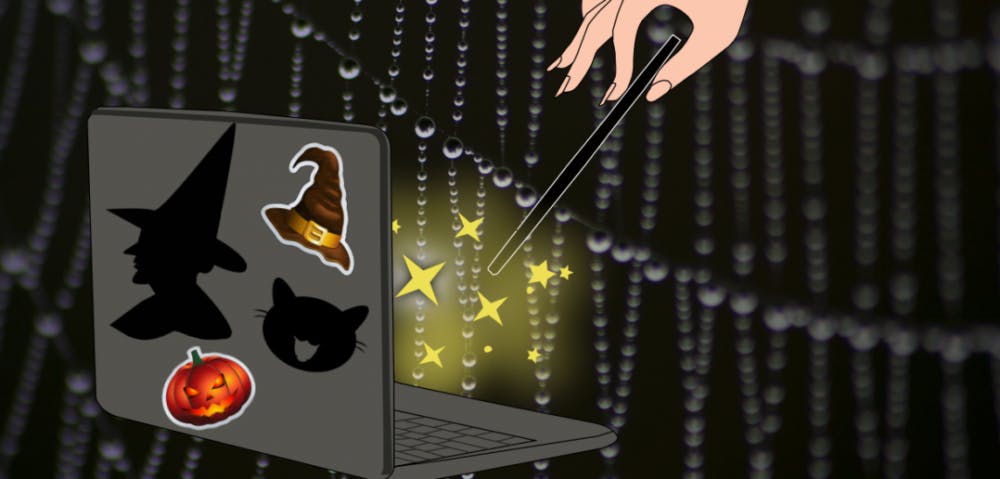Odds are, you’re going to spot a witch this Halloween. Browsing any costume shop, you can easily find the pointed hat, an assortment of brooms, dark capes and velveteen dresses. This witchy aesthetic of black-painted nails fanned over tarot cards, dried herbs hanging from ceilings, and crystals scattered in moonlight is now admired all year long, and sometimes by those who claim to be witches themselves.
Being a witch is cool now
The witch aesthetic, popularized by communities that thrive on microblogging platforms like Tumblr, is defined by the celebration and adoration of all things occult: spells, crystals, potions and black cats. There are entire blogs filled with photographs of tarot card spreads and images from a darklit side of nature.
And there is indeed a significant community on Tumblr that practices witchcraft, and perhaps because of these beautiful images of triple moons and candles, more have been inspired to take up the craft.
“On one hand I am very happy to see so many people interested in witchcraft, or even Wicca or something, but on the other hand I’m very wary,” said Kora Wilson, a Ball State senior who identifies as a Grey Witch and Wiccan, “People think witchcraft and magick are often like Harry Potter or Charmed or even The Craft. Magick and practicing magick isnt like that.”
Witchcraft goes back thousands of years, and almost every culture has some reference to it. Just as universally, witchcraft was viewed generally as an evil practice—something wielded against others. Modern magic practice or Neopaganism began as a movement in the ’50s and ’60s, eventually leading to formation of Wicca and other religions. Narratives like Harry Potter further served to soften the witch image from an old crone or evil woman who would be burned alive by a mob of townsfolk to something more innocuous, mysterious and even tempting.
Wilson, who is the President of the Society for Earth-based Religions, says that witchcraft has no single defined way of practice, but warns that the Internet is not always the best place to find sources on how to go about being a witch.
“But for every one good source on witchcraft or magick there is like five terrible sources or misleading sources. So you really have to either know what you’re trying to find, or definitely take everything with a grain of salt and back up what you’re finding before thinking its fact.”
Posting witchy stuff doesn’t make you a witch
When millennials jump on a trend, typically retailers are just a step behind, and when it comes to the witch aesthetic this is just what we see happening—crystals being sold in Urban Outfitters, books of shadows found in the trending sections of Books-A-Million, and shirts from Forever 21 featuring pentagrams. Not to mention the plethora of spells available for purchase on Etsy.
These items seem to be hawked and bought with consumers oblivious to their meaning within witchcraft. Not everyone who wears crystals and rune stones is necessarily a witch.
“In a way I think it is culturally appropriative. Because witches and pagans are a minority and have always been persecuted or looked at negatively. And for me, who has lived and identified as a pagan and witch for close to ten years it seems like they have a way out, they have a way to take off their outfits ad accessories and be themselves, and I can’t.” said Wilson.
When movements are commercialized, there’s not much information attached to the product to explain it’s significance it has to those within the aforementioned practice. People buying witchy things like sacred smudge mist from might not even know what smudging is, they just like the scent.
“I believe its only appropriative if you don’t understand the meanings behind what you’re saying. One can appreciate the spoopy and the witchy, certainly, but understand that culture, those people, and the meaning behind whatever symbols you wear.” said Wilson.
Can magic and technology co-exist?
Technology and magic might sound antagonistic, like fire and water, but recently there have been examples of the power of magic and the might of the Internet coming together for a common cause. Like when thousands of witches casted a mass hex on Donald Trump.
Wilson bursts into laughter. “That happened. I thought it was amazing that so many people hexed Donald Trump. I feel like this could have not happened had technology not existed. Otherwise it would have taken probably months to come together like that.”
Some people use the Internet specifically for spellwork, combining tech and magic directly. Wilson often uses the Internet as a resource for her spells and finding ingredient substitutions. Rather than scouring local bookstores, budding witches can find a plethora of magical resources online.
Is this wealth of information the reason behind the surge in magic practitioners? Is it the appeal of the witch aesthetic? Or could it be something more related to the millennial mindset?
“Our generation is all about being responsible, working hard, and not blaming others for our problems but owning up,” said Wilson, “And ultimately magick, witchcraft, paganism is all about owning up to your mistakes, your actions, and being responsible for yourself on your own.”
She adds, “But also, being a witch is cool, its fun, its interesting, its neat.”
Sources: Tumblr, Urban Outfitters, Refinery29, Pow Wow Power, Vox
Images: Kora Wilson, Tumblr, Twitter
For more entertainment related content, visit us at Byte Bsu!




















